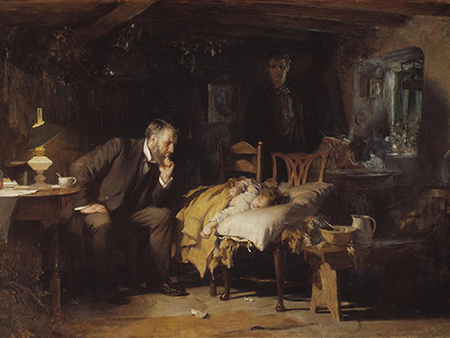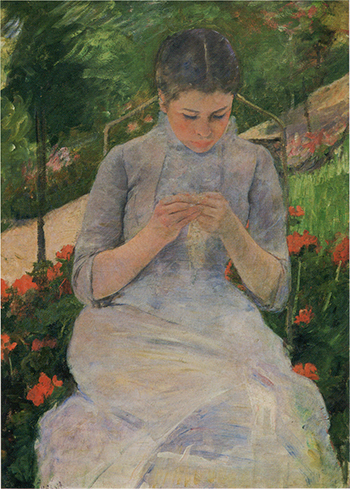 Sir Luke Fildes, "The Doctor," exhibited 1891Can art help doctors better understand their patients and address racial disparities?
Sir Luke Fildes, "The Doctor," exhibited 1891Can art help doctors better understand their patients and address racial disparities?
An innovative collaboration at the University of Alabama at Birmingham uses art to help medical students hone their observational skills, in order to make more accurate diagnoses.
“Prescribing Art: How Observation Enhances Medicine” is a partnership between the School of Medicine, the Abroms-Engel Institute for Visual Arts and the Birmingham Civil Rights Institute. The idea was launched by Stephen Russell, M.D., special topics course coordinator and associate professor of internal medicine and pediatrics.
“To our knowledge, this is a first-of-its-kind course, using an existing collaboration with AEIVA,” Russell said.
Dean of the UAB School of Medicine Selwyn M. Vickers, M.D., has called on medical schools to focus on cultural competence and racial biases, both exposed by COVID-19. Vickers wrote in an Op-Ed to the Association of American Medical Colleges on April 30 that the novel coronavirus pandemic had underscored the need for academic medical centers “to equip medical students with an understanding of cultural competence, help them recognize and address racial bias in medicine, and teach them about the costs of health disparities — both as they affect patient outcomes and the health care system at large — is vital to improving care and reducing costs in the long run.”
The challenges of COVID-19 allowed the teaching team to think creatively in remote education, and in doing so, they were able to offer this course in a new format with new partners to more medical students. The course was attended by nearly 30 students from the class of 2021, as well as two faculty members from Stanford University.
 This image was used in John Fields' discussion about the tolerance of ambiguity. This discussion was intended to help the students, through interpreting different meanings in contemporary artworks, get more comfortable with the basic idea of ambiguity — something they often encounter in their clinical practice and patient diagnosis. David Levinthal, b. 1949, "Untitled," from the series "Wild West," 1989 Polaroid Polacolor ER Land Film, 2017.042. Anonymous gift. Collection of the Abroms-Engel Institute for the Visual Arts, UAB.The collaboration and success pave the way for future educational initiatives needed during this moment in time, particularly in addressing COVID-19 and systemic inequality, Russell says.
This image was used in John Fields' discussion about the tolerance of ambiguity. This discussion was intended to help the students, through interpreting different meanings in contemporary artworks, get more comfortable with the basic idea of ambiguity — something they often encounter in their clinical practice and patient diagnosis. David Levinthal, b. 1949, "Untitled," from the series "Wild West," 1989 Polaroid Polacolor ER Land Film, 2017.042. Anonymous gift. Collection of the Abroms-Engel Institute for the Visual Arts, UAB.The collaboration and success pave the way for future educational initiatives needed during this moment in time, particularly in addressing COVID-19 and systemic inequality, Russell says.
The virtual course, live and interactive and taught through Zoom, was done the last week of April in response to the pandemic, with small and large group settings. The team reformatted an existing “Art in Medicine” course Russell has taught since 2011 to use the medium of art to help medical students achieve improved observational skills across three domains: in clinical encounters, in their perceptions of biases, and in their tolerance of ambiguity or uncertainty.
“Each of these domains is a fundamental skill to learn, and each is challenged by the distancing of COVID-19,” Russell said.
The goal is to improve those skills through a course designed to expose, educate and strengthen elements of awareness. It is built on the evidence-based foundation that sharp observation skills, which are fundamental to effective clinical decision-making, can be taught and improved.
Learning from other expert observers, such as artists, can help physicians too. Teachers in the course included Russell and Wood; AEIVA Senior Director John Fields and Education Manager Christina McClellan; Stephanie Crumpton, associate professor and curator of the UAB Alabama Museum of the Health Sciences; and Karmie Johnson, DNP, CRNP, assistant professor in the UAB School of Nursing; as well as Rachel White, curator of education, Birmingham Museum of Art.
“The Birmingham Civil Rights Institute is dedicated to using what we have learned in the past, to educate the present, in order to chart a better future,” said Charles Woods III, BCRI education programs manager and community engagement coordinator/exhibitions. “We were delighted to assist in helping future doctors recognize where they might be functioning based on their own prejudices and biases and how that affects the diagnosing and treatment of their patients and ultimately how this contributes to disparity in healthcare.”  Mary Cassatt, "Girl in the Garden," between 1880 and 1882, oil on canvas.©️ RMN-Grand Palais (Musée d'Orsay) / DR
Mary Cassatt, "Girl in the Garden," between 1880 and 1882, oil on canvas.©️ RMN-Grand Palais (Musée d'Orsay) / DR
Some of the works used in the course include Mary Cassatt’s “Young Woman Painting in the Garden” (1880); Paul van Somner’s “Queen Anne of Denmark” (1617); Michelangelo’s “Dying Slave” (1513); Ghirlandaio’s “An Old Man and His Grandson,” (1490); “Bust of Hadrian” (first century BCE); and Sir Luke Fildes’ “The Doctor” (1891). Reading for the course included “How to Use Your Eyes” by James Elkins and “The Intelligent Eye: Learning to Think by Looking at Art” by David Perkins.
“UAB’s mission creates an environment that fosters interdisciplinary opportunities in regard to education and research,” Fields said, “and we try to mirror that at AEIVA. We believe that art has an innate ability to act as a conduit for discussions that cross all academic disciplines. This course is that belief fully realized.”